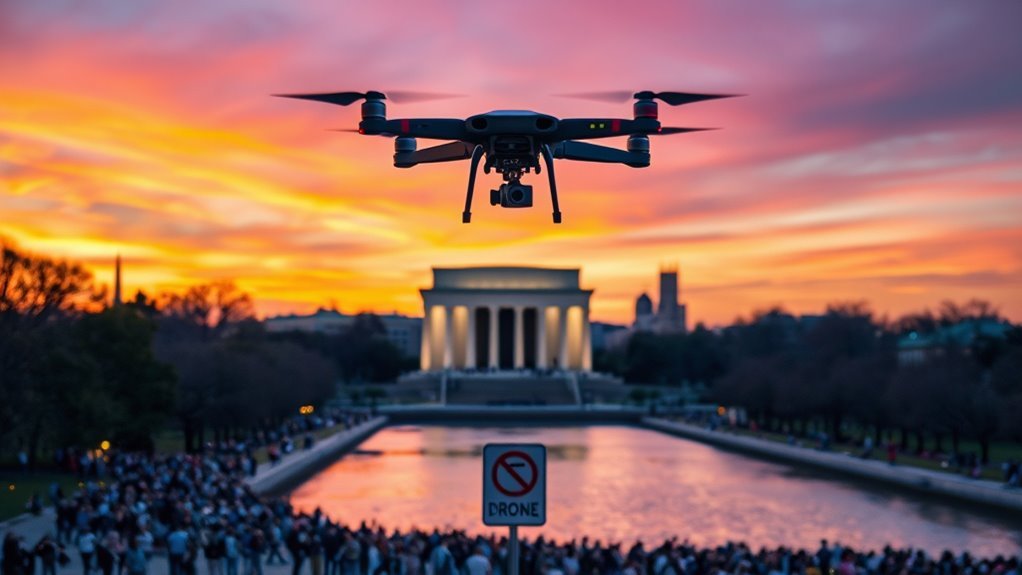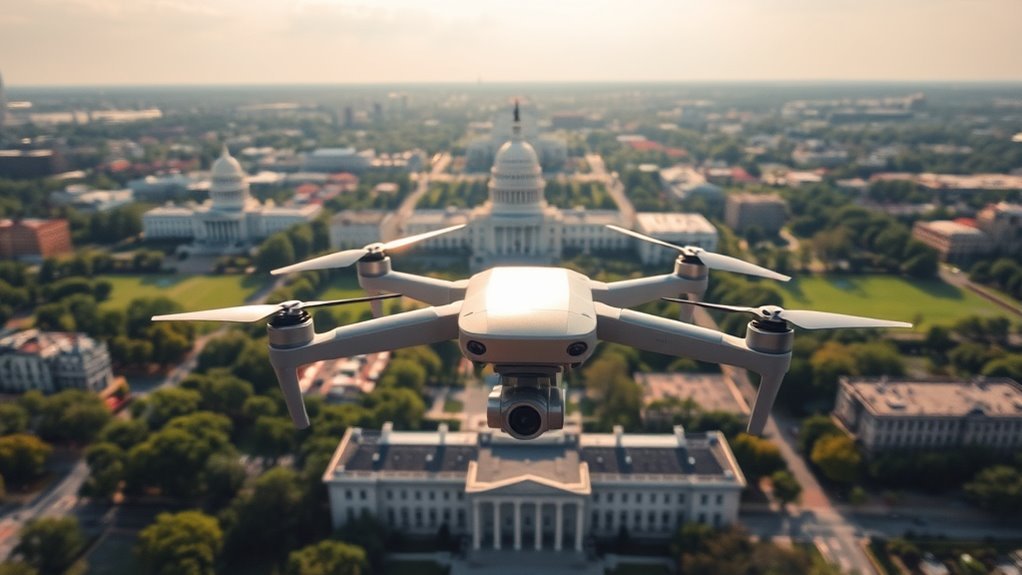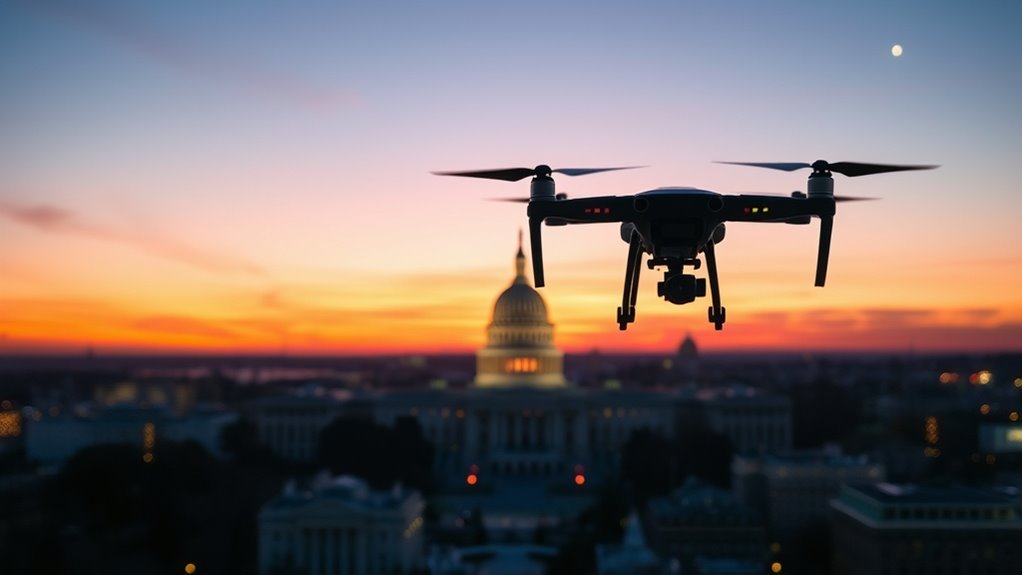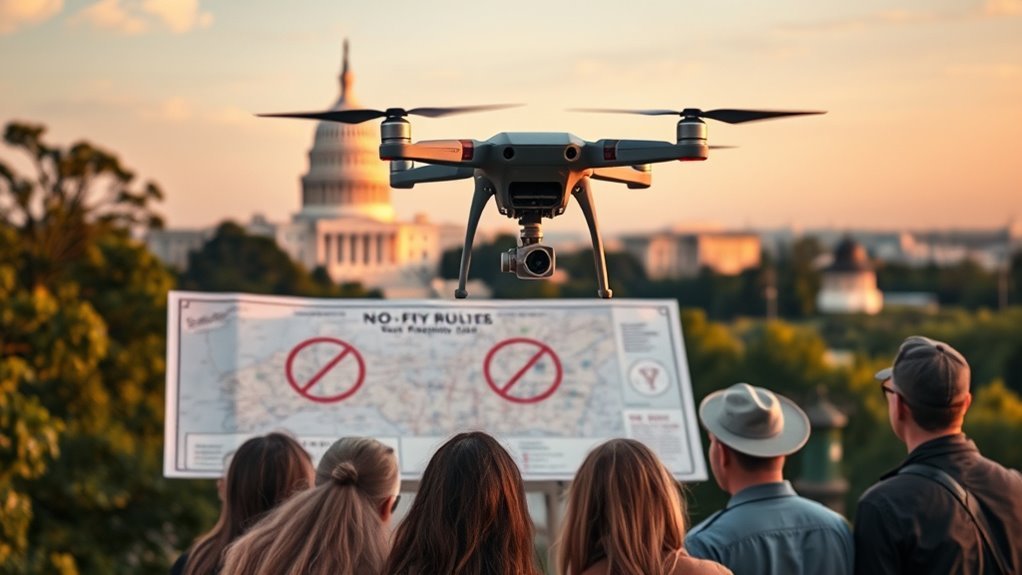To fly drones in D.C., you must adhere to FAA regulations, including registering drones over 0.55 pounds and displaying your registration number. Avoid no-fly zones, especially around national parks and federal buildings. Maintain altitude below 400 feet and keep your drone within visual line of sight. If flying at night, equip your drone with proper lighting. For commercial pilots, respect privacy laws and obtain necessary exemptions. There are more detailed guidelines to contemplate for safe operations.
Understanding the Federal Aviation Administration (FAA) Regulations

When operating a drone in Washington, D.C., understanding FAA regulations is vital for compliance and safety. The FAA guidelines dictate that you must register your drone if it weighs more than 0.55 pounds. You’ll need to guarantee your drone remains below 400 feet and within your line of sight at all times. Additionally, avoiding flight near airports or other crowded areas is essential for drone safety. Familiarize yourself with the specific rules about flying during daylight hours and maintaining a safe distance from people and property. Adhering to these regulations not only protects your freedom to fly but also enhances the safety of others. By understanding and following these FAA guidelines, you’re empowered to enjoy your drone experience responsibly.
No-Fly Zones in Washington, D.C

In Washington, D.C., you’ll encounter several no-fly zones that you must adhere to while operating drones. National parks, specific airspace regulations, and proximity to federal buildings impose strict restrictions that are critical for maintaining safety and security. Familiarizing yourself with these guidelines is vital to guarantee compliance and avoid potential penalties.
National Park Restrictions
Although drone enthusiasts may be keen to explore the skies above Washington, D.C., it’s important to understand that numerous national parks within the city are designated no-fly zones. These restrictions are vital for wildlife protection and maintaining the natural integrity of these areas. Engaging in drone photography in these zones not only violates federal regulations, but it can also disrupt local ecosystems and harm wildlife, particularly nesting birds and other sensitive species. You’ll need to familiarize yourself with park boundaries and adhere strictly to these regulations to avoid significant penalties. Remember, respecting these no-fly zones preserves the beauty of D.C.’s national parks and guarantees that future generations can enjoy them as you seek to capture their essence through your lens.
Airspace Regulations
Washington, D.C. is home to several critical no-fly zones that drone operators must navigate carefully. Understanding airspace classification is crucial for compliance. The city’s drone zones include areas where flying is strictly prohibited, primarily for security and safety reasons.
Be aware of the following:
- Restricted airspace surrounding federal buildings and monuments
- Proximity to airports, which may limit flight paths
- Temporary flight restrictions (TFRs) during special events or emergencies
Failing to adhere to these regulations can lead to legal consequences and threaten public safety. It’s essential to stay informed about changing airspace classifications and restrictions to guarantee a responsible and enjoyable flying experience in D.C.’s unique landscape.
Federal Building Proximity
Flying near federal buildings in D.C. presents significant restrictions that drone operators must heed. These no-fly zones are essential for maintaining federal security and guaranteeing drone safety. Ignoring these regulations can result in serious legal consequences.
| Zone Type | Proximity (feet) | Key Restrictions |
|---|---|---|
| Restricted Area | 0-500 | No drone operations allowed |
| Caution Area | 500-1,000 | Limited drone usage, check local laws |
| Advisory Area | 1,000-2,000 | Exercise caution, remain aware of surroundings |
| Open Area | 2,000+ | Regular rules apply, ensure compliance |
Understanding these zones is crucial for responsible drone operation in D.C. Always prioritize safety and abide by the established regulations to enjoy your freedom in the skies responsibly.
Registration Requirements for Drones

To legally operate a drone in D.C., you’ll need to complete the registration process mandated by the FAA, which includes specific fees. Understanding the nuances of these fees and identifying any exemptions or exceptions that may apply to you is essential. Compliance with these requirements guarantees you’re flying within the law and helps avoid potential penalties.
Drone Registration Process
Before you can operate a drone in D.C., you’ll need to navigate the registration process, which is vital for compliance with both federal and local regulations. This process guarantees drone safety and is significant for those using their drones for recreational purposes.
To successfully register your drone, keep in mind these key steps:
- Determine if your drone needs registration: Weigh its weight and purpose to see if you qualify.
- Complete the registration online: Visit the FAA website to fill out the necessary forms.
- Display your registration number: Affix the registration number to your drone for visibility.
Registration Fees Overview
While understanding the registration process, it is essential to take into account the associated fees for drone registration in D.C. The registration costs typically vary depending on the type of drone you own and its intended use. For most recreational drones, a nominal fee is required, while commercial operators may face higher compliance fees due to the additional regulations they must follow. It’s important to be aware that failure to pay these fees can result in penalties or denial of your registration application. By ensuring you understand and comply with these financial obligations, you’ll not only maintain your legal standing but also preserve your freedom to operate your drone effectively within D.C.’s airspace.
Exemptions and Exceptions
Although registration is generally mandatory for drone operators in D.C., certain exemptions and exceptions exist that may relieve you from this requirement. Understanding this exemptions overview is essential for maximizing your freedom while flying. Here are specific scenarios where registration isn’t needed:
- If your drone weighs less than 0.55 pounds (250 grams).
- For educational purposes, like flying in school programs under supervision.
- If you’re using the drone exclusively for recreational purposes in designated areas.
These exceptions allow you to operate your drone without the burden of registration, provided you adhere to local regulations. Always verify your situation to confirm compliance and to fully enjoy the freedom of flying your drone in D.C.
Altitude and Distance Limitations
When operating drones in Washington, D.C., it’s important to adhere to specific altitude and distance limitations set by local regulations. You must maintain an altitude below 400 feet to avoid interference with manned aircraft and guarantee safety. Additionally, keep your drone within a distance of 1 mile from any airport, as drone technology can pose risks to aviation. Altitude awareness is vital; exceeding these limits can lead to fines or loss of flying privileges. Familiarize yourself with the designated no-fly zones, especially around sensitive areas like the Capitol and White House. By understanding and respecting these limitations, you can enjoy the freedom of flying while maintaining compliance with local laws and safety standards.
Maintaining Visual Line of Sight
Maintaining visual line of sight (VLOS) is essential for safe drone operation in D.C. You need to guarantee that you can always see your drone while it’s in flight. This visual awareness not only helps you maintain control but also allows for effective drone spotting, preventing potential collisions with other aircraft or obstacles.
- Keep your drone within 400 feet of your position.
- Avoid flying in areas with obstructions that limit visibility.
- Use spotters if necessary to maintain line of sight.
Restrictions on Night Flying
Flying drones at night in D.C. is subject to strict regulations, as visibility is considerably reduced and risks increase. To operate your drone after dark, you must equip it with appropriate lighting to enhance night visibility. This guarantees not only your drone’s visibility to others but also aids in directing your flight path safely. Additionally, you’re required to follow specific safety measures, such as adhering to altitude restrictions and maintaining a clear line of sight, even at night. Remember, flying without these measures can lead to serious penalties and compromise safety. If you wish to explore the freedom of night flying, be vigilant about these regulations to enjoy your experience responsibly and legally.
Privacy Concerns and Respecting Others
Although you may be excited to capture stunning aerial footage, it’s important to recognize the privacy concerns that come with flying drones in urban environments like D.C. Respecting the privacy rights of individuals is vital for ethical flying. Remember, your drone shouldn’t intrude on others’ personal space or violate their expectations of privacy.
Consider these points:
- Know where you’re flying: Avoid areas where people expect privacy, such as backyards or private properties.
- Seek permission: When in doubt, ask for consent before filming individuals.
- Stay informed: Familiarize yourself with local laws regarding privacy and drone operation.
Special Considerations for Commercial Pilots
When operating drones for commercial purposes in D.C., it’s crucial to adhere to stricter regulations and guidelines than those for recreational users. For commercial drone operations, you’ll need to obtain a Section 333 exemption from the FAA, guaranteeing compliance with all safety and operational standards. Your business drone usage must also adhere to altitude restrictions, no-fly zones, and specific airspace regulations. Additionally, you must maintain visual line-of-sight during flights and confirm your drone is registered. A unique identification number must be affixed to your drone to ensure compliance with these regulations. Insurance coverage is highly recommended to protect against liabilities. Failing to comply can result in significant penalties. Embracing these rules not only keeps you compliant but enhances your operational freedom while pursuing your business objectives in D.C.’s complex airspace. Furthermore, understanding local drone regulations is essential to ensure safe and legal operations in residential areas.
Reporting Incidents and Compliance Enforcement
Since compliance with drone regulations is critical for maintaining safety and order in D.C.’s airspace, promptly reporting any incidents or violations is vital. Failing to report can lead to severe compliance penalties, impacting your ability to operate freely.
When you encounter an incident, make certain you:
- Document the event thoroughly, noting time, location, and details.
- Report the incident to the appropriate authorities immediately.
- Keep records of your communications for future reference.
Frequently Asked Questions
Can I Fly Drones for Recreational Purposes in D.C.?
You can fly drones for recreational purposes in D.C., but you must adhere to strict drone safety protocols and flying guidelines. Always check for no-fly zones and guarantee compliance with all local regulations to enjoy your experience.
What Are the Penalties for Violating Drone Regulations?
Violating drone regulations can lead to significant fines and penalties. You’re exposing yourself to legal consequences that may include monetary fines, potential criminal charges, and restrictions on future drone operations. Stay informed to maintain your freedom.
Are There Specific Drone Models Prohibited in D.C.?
In D.C., certain drone models are prohibited due to safety concerns. It’s essential you know which models can’t be used to guarantee compliance and promote drone safety. Staying informed helps you enjoy your flying experience responsibly.
How Do I Report a Drone-Related Incident?
To report a drone-related incident, follow established reporting procedures. Guarantee accurate incident documentation, including date, time, and location. Submit your report to local authorities or relevant agencies to guarantee proper investigation and resolution.
Can I Fly a Drone Near a Federal Building?
You can’t fly a drone near federal buildings due to strict federal restrictions. Prioritize drone safety and compliance to avoid legal issues, ensuring your flying experience remains enjoyable without compromising national security or personal freedom.

